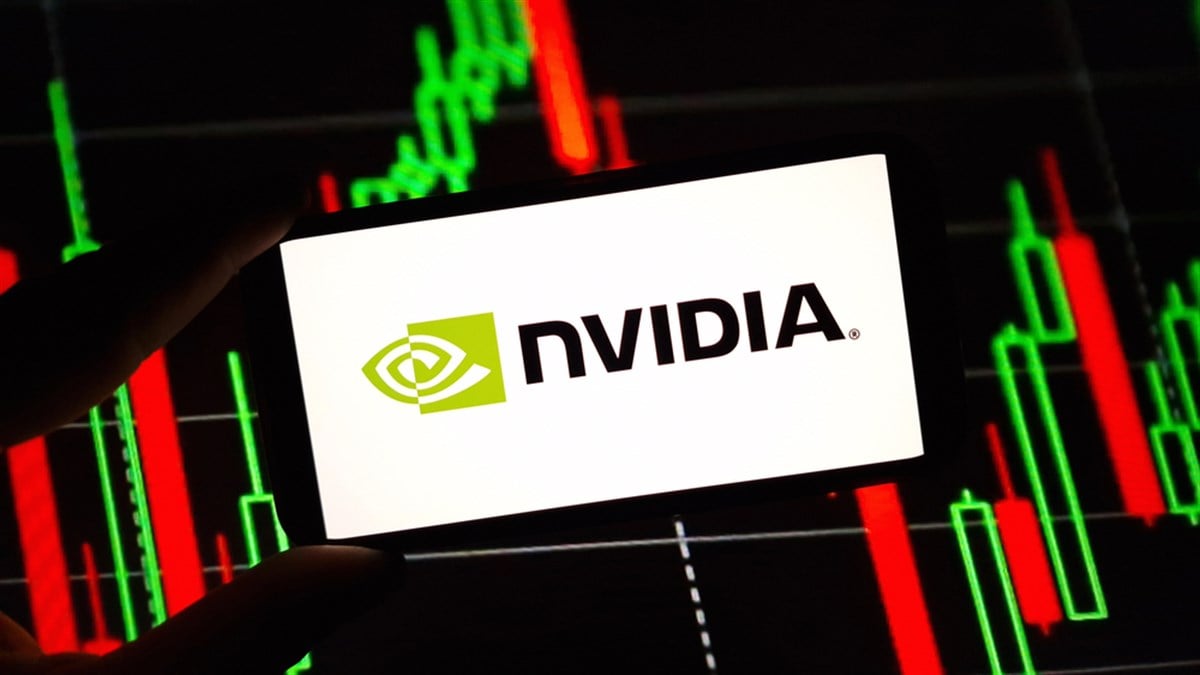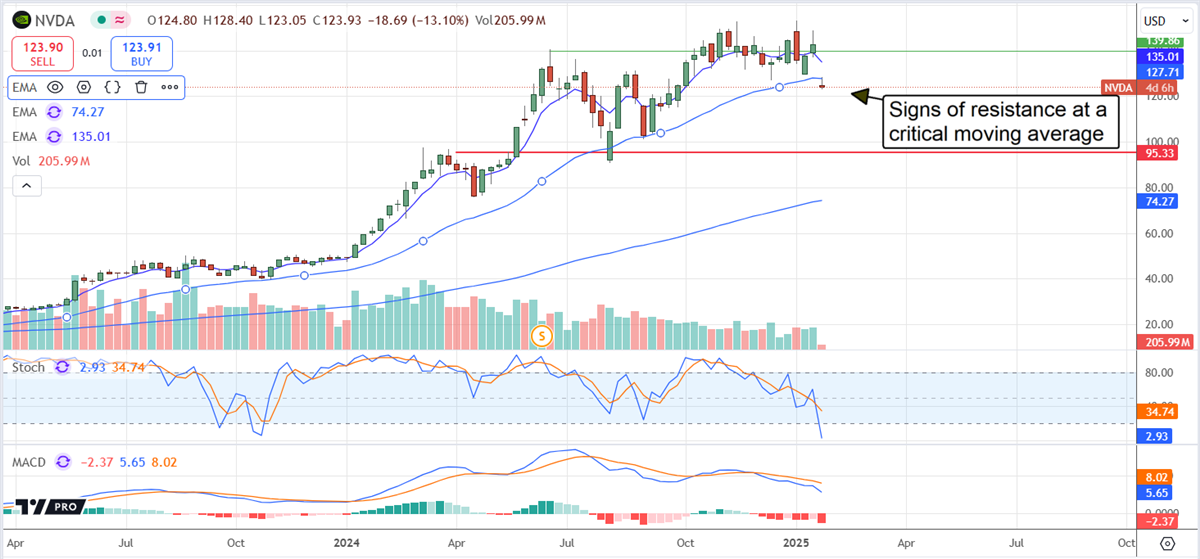Your Free Book for Crypto Bull Run Riches (From Crypto 101 Media)
Written by Thomas Hughes 
NVIDIA (NASDAQ: NVDA) stock plunged more than 10% on news from China AI that rocked the AI world. The launch of DeepSeek raises questions about the cost of computing and NVIDIA’s position in the data center and AI industry, but take it with a grain of salt. DeepSeek’s claim to have cost only $6 million is disputed by experts and unverifiable. There’s no telling how much money went into the project to get it to the point of only costing $6 million, and other factors are in play. DeepSeek’s founder and principal funder, Liang Wenfend, has ties to the Chinese government and reason to skew the data, given the escalating technology war between China and the U.S. The flip side is that China’s advances in AI technology are offset by the United States' dominant technological position. While the advent of lower-cost models may have a near-term impact on the market, the longer-term outlook is solid. The advancement of AI will be driven across the stack, including chip advancement, and NVIDIA is the critical player. Not only are its chips central to the AI boom, but its CUDA operating platform is also essential. It unlocks and harnesses GPU power for AI development; major updates will be forthcoming. Blackwell production has ramped up to 100%; there are plans for capacity expansion, including into the U.S., and the next-gen technology will soon be available. Rubin, the next iteration of NVIDIA’s GPU technology explicitly built for AI, is expected in the second half of this year, fully six months ahead of best-case scenarios in late 2024. Analysts Pan the News: DeepSeek Not a Competitive Threat The analyst's response is to pan the news. Wedbush analyst Dan Ives says DeepSeek will cause ripples, but neither it nor China can match the United States AI endgame, including the infrastructure and ecosystem to operate. In his view, the price plunge is an opportunity to load up on a bundle of leading AI names, including Microsoft (NASDAQ: MSFT), Palantir (NASDAQ: PLTR), and Salesforce (NYSE: CRM). The most recent Wedbush and rating tracked by MarketBeat is from October 2024, when the price target was lifted to $175. That is above the mid-January consensus figure, which implies more than 30% following the DeepSeek driving sell-off. The analyst sentiment trends for NVIDIA are bullish. These trends include increased coverage, firming sentiment, and an increasing consensus price target. The consensus forecasts a 30% upside; the revisions trend suggests a move to the high-end range, which adds another 36% to it. The risk in the sentiment is that subsequent earnings reports will fail to impress, and the price targets will start falling. NVIDIA’s FQ4 2025 results are due in late February, and the bar is set high. Thirty-four of the 85% of analysts tracked by MarketBeat increased their revenue and earnings targets since the last report. They forecast another sequential growth, with YOY growth slowing to 75% and earnings growing slower. The likely reality is that NVIDIA will outperform the consensus as it has for the last two years and drive a wider margin with the leverage. NVIDIA’s Cash Flow Will Help Sustain Upward Price Momentum Over Time One of the critical details for NVIDIA investors is the increased leverage and cash flow provided by the booming GPU business. The company’s cash pile was up 50% YTD at the end of Q3, receivables, and inventory were up, total assets were up, and the company was net cash relative to total liability. The long-term debt position is small and manageable, leaving NVIDIA in a solid position to buy back shares, pay its dividend, and increase its capital return steadily over time while reinvesting in AI and maintaining a fortress position. The price action is iffy following the release. The price plunged more than 10% and showed resistance at a critical level in early trading. That level aligns with the 150-day EMA, a significant level if confirmed as resistance. In that scenario, the stock price could fall to the bottom of a long-term trading range. 
It's a groundbreaking opportunity that could be poised for extraordinary gains.
The catalyst behind this surge is a massive new blockchain development… YES, I WANT THE #1 CRYPTO NOW Written by Gabriel Osorio-Mazilli 
When market volatility compresses, as it did over the past five days, seasoned investors and traders should consider what could happen next to bring about a spike in volatility, such as unusual trading volume or options trading activity. This week’s volatile event, coming in to end the first month of 2025, comes all the way across the world from Asia’s powerhouse. In China, a group of developers has released their own version of an artificial intelligence-driven chat system, such as OpenAI’s ChatGPT. This new system, called DeepSeek, apparently has over twice the computing power at a fraction of the cost, which deeply challenges the current state of semiconductor supply and demand in today’s market. The market is reacting to the news by selling off one of the most overextended names in the technology sector today. Shares of NVIDIA Co. (NASDAQ: NVDA) are down over 10% to start the new trading week, bringing other stocks and indexes down with it as it became the biggest holding in some portfolios across the board. Investors will understand why this is happening and how the whole situation likely ends from here, with risks put aside and opportunities kept in focus. Is DeepSeek Truly Better? The simple answer to this question is a resounding yes, as long as investors trust the information and statistics coming out of China. Another gauge, probably more foolproof, can be taken from actually trying out the product. Now that DeepSeek has become the most downloaded application in the world, chances are these claims aren’t false. With this in mind, there is a significant conflict in the industry as a whole: whether more can be done with less. This is the proposition coming out of China, which is why the market’s price action rewards some of the technology names in that nation while punishing United States technology stocks. For example, the KraneShares CSI China Internet ETF (NYSEARCA: KWEB) is rallying by over 1% while the Nasdaq-100 is down over 1% on the other hand; another clear example is Alibaba Group (NYSE: BABA) rallying by over 2.2% in a single day despite this bearish view for technology stocks overall. This price action might mean that the estimates for costs and capital intensity might have gotten away from these giant names. Looking at the recent producer price index (PPI) and manufacturing PMI reports, investors would realize that demand for semiconductors and chips had taken a backseat. However, NVIDIA and other leading names kept producing inventory as if the demand cycle was still at the upper end of the range. As the laws of economics go, oversupply will lead to a needed adjustment. This is why DeepSeek might have chosen to launch now and not earlier, knowing that the data would favor them. Is There a Way Out? For those looking to play their hand in this situation, the best thing to do would be to keep portfolios away from all this volatility and focus more on great risk-to-reward setups. One stock in the United States that could fit this criteria is Advanced Micro Devices Inc. (NASDAQ: AMD), as a few factors would favor it over NVIDIA today. First, Wall Street analyst price targets would favor Advanced Micro Devices. The consensus is set for $176.3 a share, which calls for up to 50% upside from today’s price. Compared to NVIDIA, its price target of $164.6 a share calls for a much lower 29.8% upside from today’s levels alone. More than that, some analysts might adjust their valuations on NVIDIA after this bold DeepSeek achievement and claim. Secondly, the fact that NVIDIA stock is selling off by over 10% while Advanced Micro Devices managed to contain its drawdown within 4% should tell investors all they need to know. This is where the risk-to-reward setup becomes important between these two names, as Advanced Micro Devices trades as low as 54% of its 52-week high, while NVIDIA stock is at a much higher 83% of its 52-week high. This way, investors could buy the semiconductor dip through the best setups today. But, for those who believe that DeepSeek can pull this all off, considering a Chinese technology name like Alibaba and its 62.3% implied upside coming from Macquarie analysts and their $145 a share price target would be a great choice. Especially as DeepSeek will rely on cloud computing services, such as the ones Alibaba is looking to expand on in the coming months. All told, the answer remains the same: so far, the evidence does stack up in favor of DeepSeek’s claims and against the stratospheric valuation multiples that NVIDIA had called for. Written by Ryan Hasson 
The consumer discretionary sector, represented by the popular Consumer Discretionary Select SPDR ETF (NYSEARCA: XLY), has recently reclaimed key moving averages, signaling resilience in its ongoing uptrend. These developments come amidst a notable shift in U.S. consumer sentiment, raising questions about the sector's near-term trajectory. Shifting Consumer Sentiment in the U.S. While the XLY ETF has found support near its uptrend’s support zone and reclaimed critical moving averages, recent data paints a more cautious picture of consumer sentiment. According to the University of Michigan's Consumer Sentiment Index, sentiment dropped to 71.1 in January 2025, down from 74.0 in December, marking its first decline in six months. This dip underscores potential concerns about the economic environment and consumer behavior. Supporting this narrative, retail sales growth in December came in at 0.4% month-over-month, falling short of expectations. Additionally, a slight rise in jobless claims to 223,000 as of January 18 suggests that while the labor market remains strong, caution is creeping into consumer decision-making. Despite this, the sector's technical performance offers a contrasting perspective. From a technical analysis standpoint, the XLY ETF's positioning remains constructive, leaving investors with key questions about its outlook. Technical Perspective: XLY Finds Support Amid Shifting Sentiment The Consumer Discretionary Select Sector SPDR Fund tracks the Consumer Discretionary Select Sector Index, encompassing industries such as retail, media, hotels, leisure, apparel, automobiles, and diversified consumer services. Despite weakening sentiment indicators, the ETF recently tested its uptrend support near $220 and held firm. Over the past week, the ETF has reclaimed its 20-day and 50-day simple moving averages (SMA) and has been consolidating above these levels. This behavior suggests the formation of a higher low within its broader uptrend, reinforcing the notion that the sector's technical structure remains intact. However, a significant momentum shift could occur if the ETF fails to hold the $220 support level. A breakdown below this level would confirm a lower high within the uptrend, signaling a potential trend reversal. Such price action, combined with weakening sentiment, could warrant a more cautious, risk-off approach to the sector. Earnings as a Catalyst: The Next 2 Weeks Are Critical The trajectory of the XLY ETF may hinge on earnings reports from its two largest holdings, Amazon.com (NASDAQ: AMZN) and Tesla (NASDAQ: TSLA), which together account for nearly 40% of the fund's weight. These earnings releases are expected to act as significant catalysts for the sector, potentially determining whether the ETF sustains its uptrend or breaks below key support levels. Amazon Earnings: February 6 Amazon, the ETF's largest holding with a 21% weighting, is scheduled to report its earnings on February 6. As the world's largest e-commerce company, Amazon's results will provide critical insights into consumer spending trends, particularly during the holiday season. Strong performance could bolster the sector's resilience, while weaker-than-expected results amplify concerns about the sustainability of consumer demand. Tesla Earnings: January 29 Tesla, the ETF's second-largest holding with a 19% weighting, will report its earnings this week, on January 29, after the market closes. As the leading electric vehicle manufacturer, Tesla's earnings will reflect its individual performance and offer insights into broader trends in discretionary spending and consumer confidence. A Pivotal Moment for the Consumer Discretionary Sector While the Consumer Discretionary Select SPDR ETF has maintained its technical uptrend, the sector faces potential challenges from declining sentiment and cautious consumer behavior. The $220 support level remains a critical line in the sand for the ETF. A break below this level could signal a broader trend reversal, aligning with weakening macroeconomic indicators. The upcoming earnings reports from Amazon and Tesla will likely be decisive events, shaping the sector's momentum for the remainder of the quarter. Investors should monitor these developments closely, as they will provide valuable clarity on whether the ETF's uptrend holds or whether a more defensive stance becomes prudent. There are very few people in this world who are considered “the best” in their field.
There are guys like Michael Jordan who is considered the best basketball player of all time…
Or Warren Buffet who is considered the best Investor of all time…
But we’ve just met a man who might be the best stock picker of all time…
Right now, as we speak, he is currently ranked the #1 stock picker in North America. If you’d like to sit down with us, follow this link here.
Looking for More Stock Ideas? |